Abstract
The adhesion of Escherichia coli to human urinary tract epithelial cells was inhibited by commercial gamma globulin, the total immunoglobulin fraction of human breast milk and urine, as well as the isolated immunoglobulin G and secretory immunoglobulin A fractions of urine from patients with acute pyelonephritis. Urinary anti-O6 antibodies reduced the adhesion of several O6 strains. Absorption of antibodies to the lipopolysaccharide of the adhering strain markedly decreased the antiadhesive capacity of all the immunoglobulin preparations, whereas elimination of antibodies to the capsular polysaccharide antigen consistently had a small but not significant effect. When urine was absorbed with whole, live bacteria of the patients' infecting strains, the antiadhesive effect completely disappeared. Absorption with bacteria lacking pili only partially reduced this effect.
Full text
PDF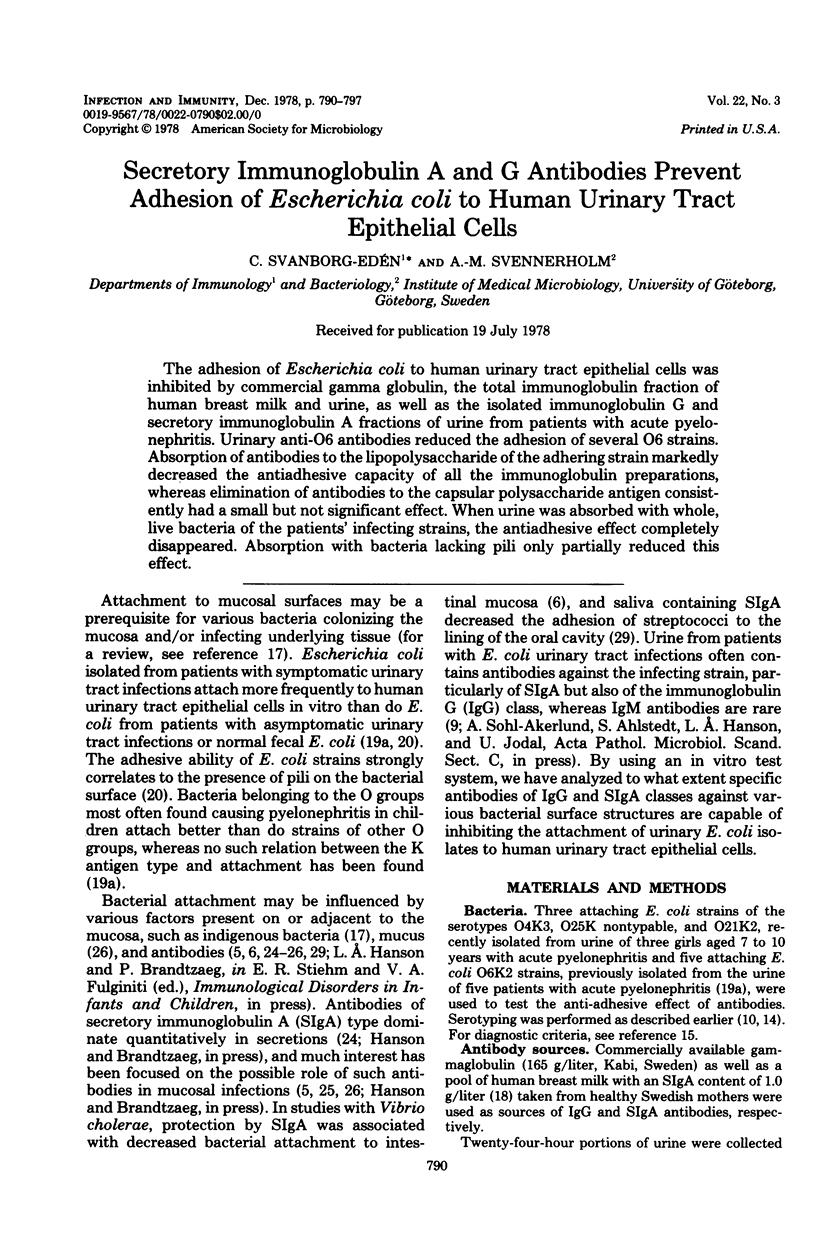
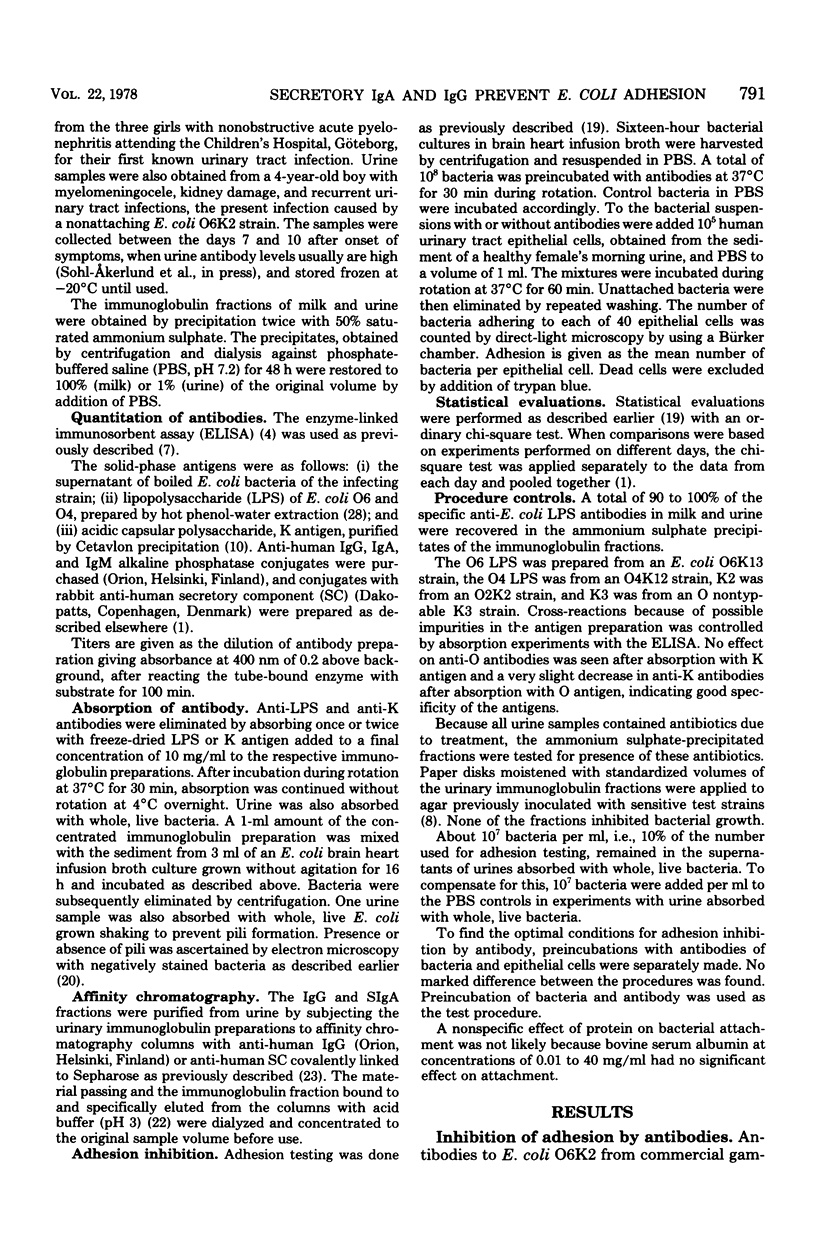

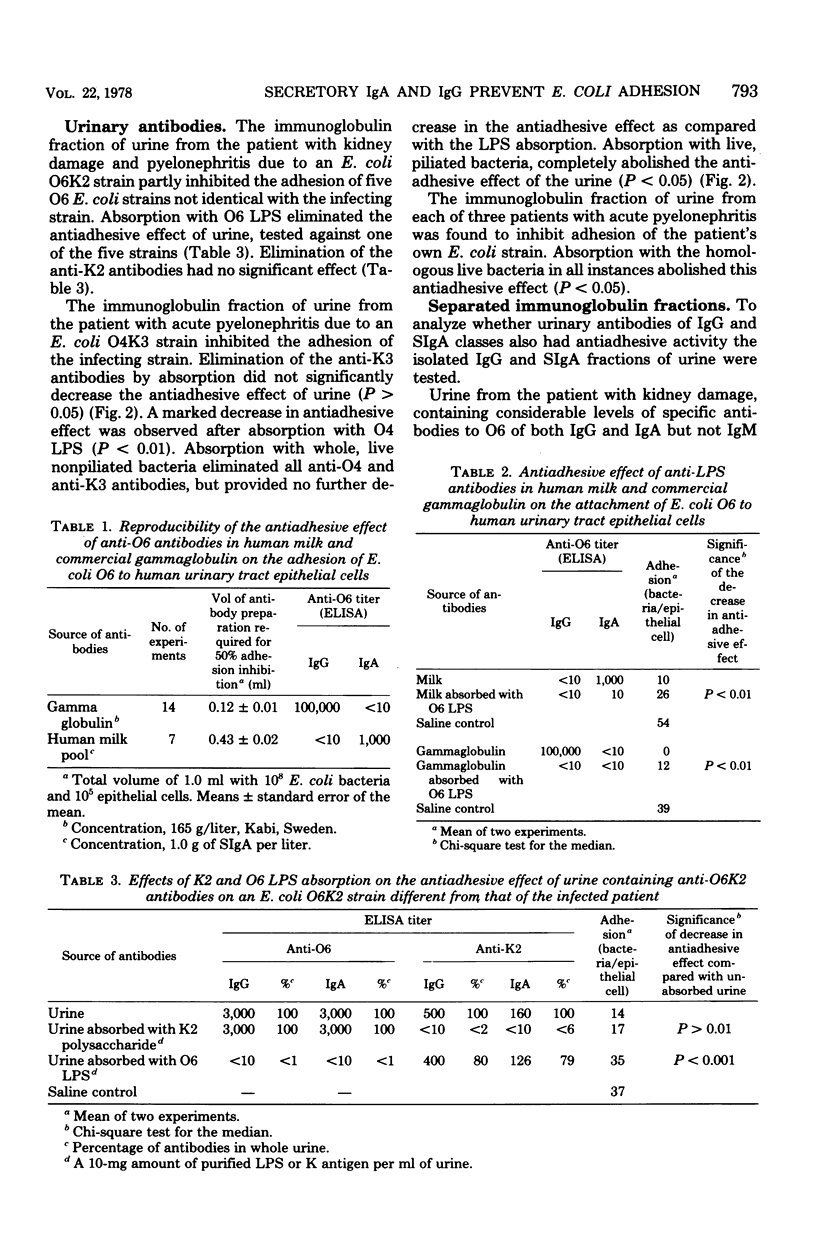
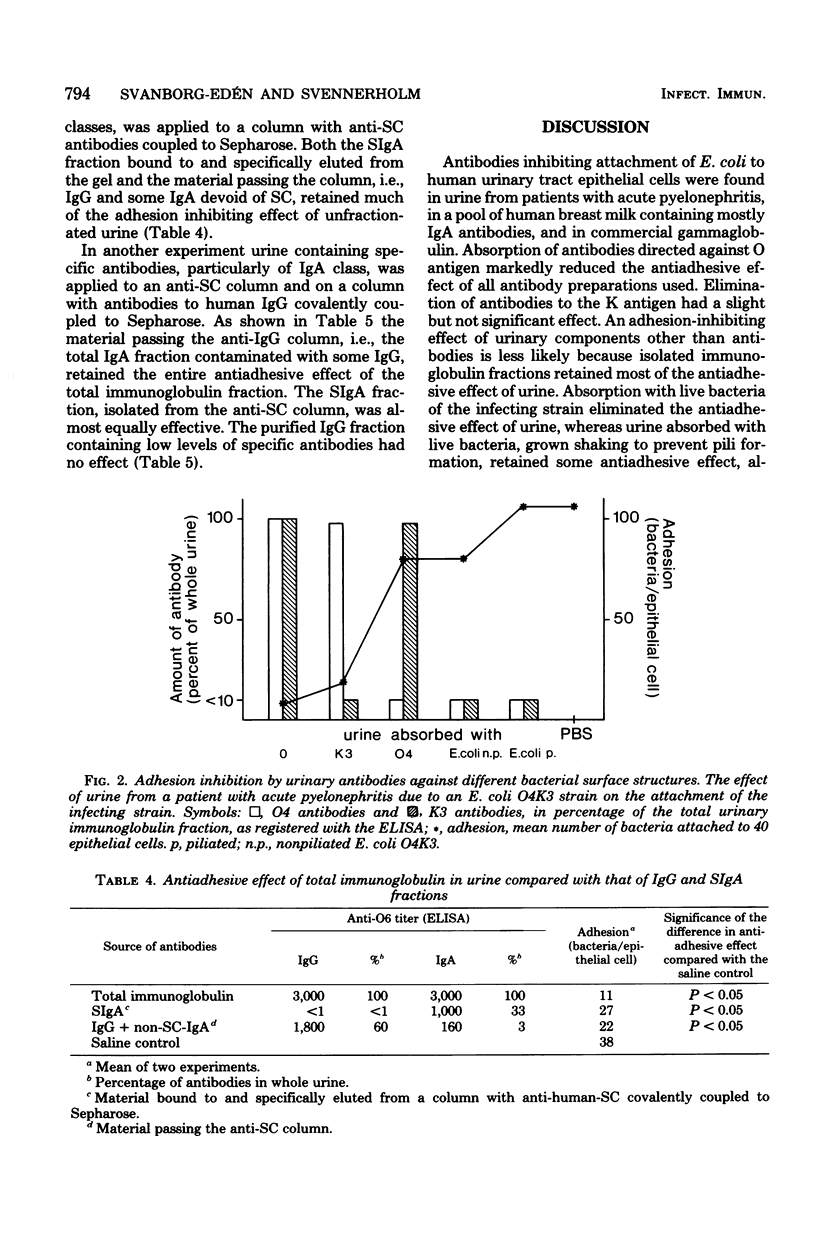
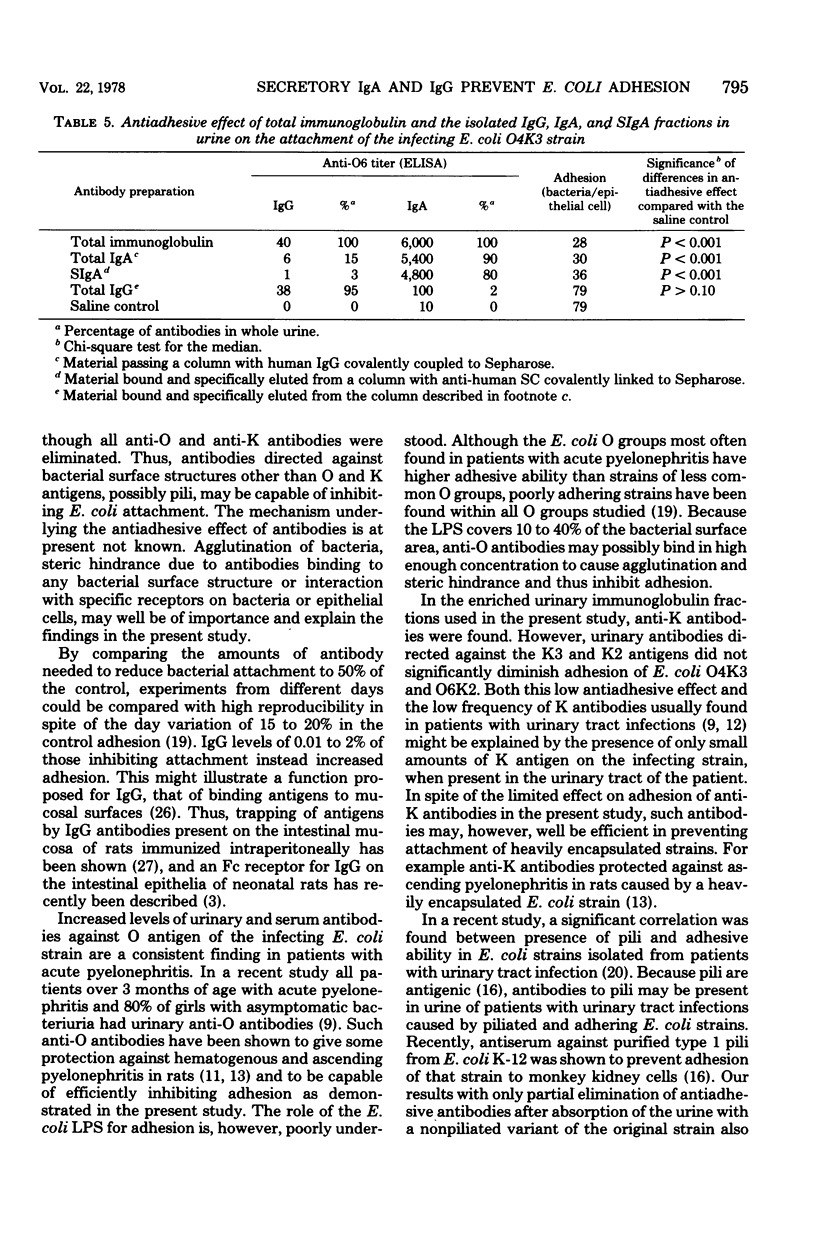
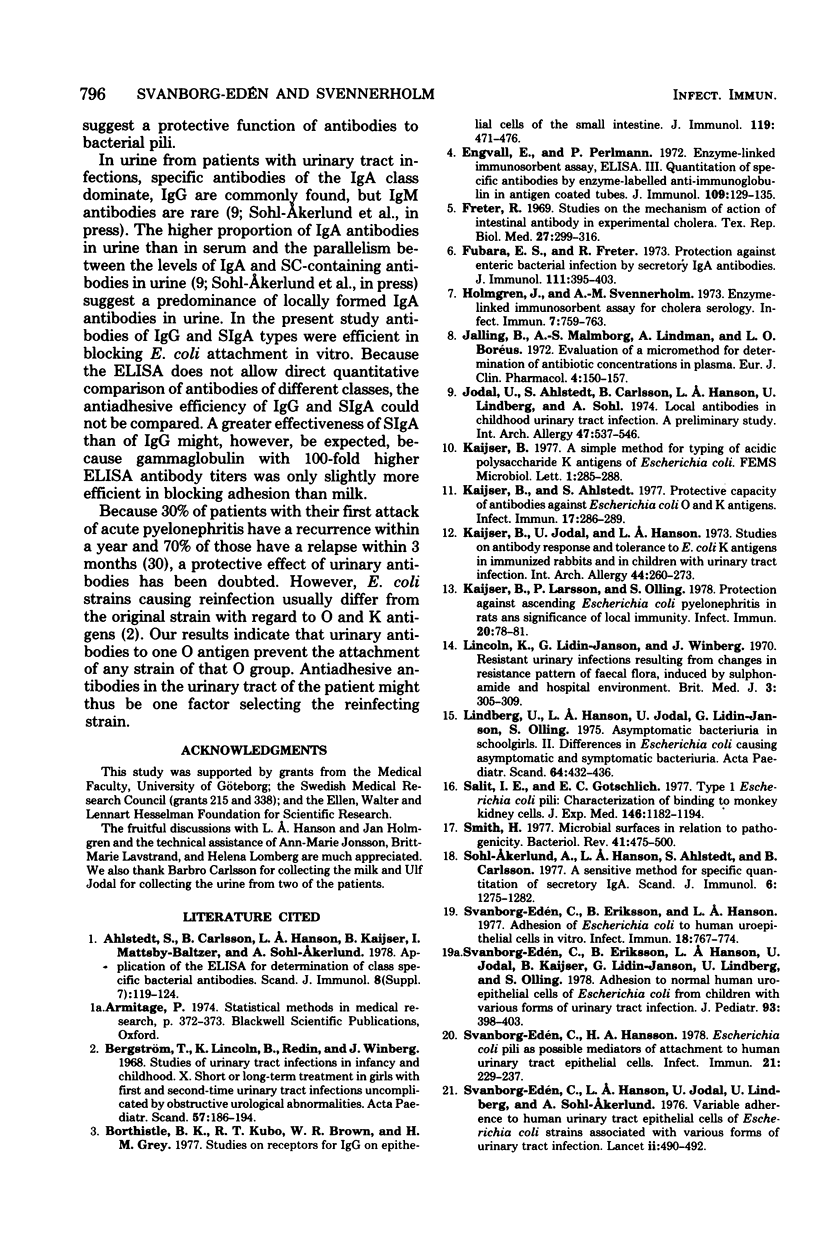
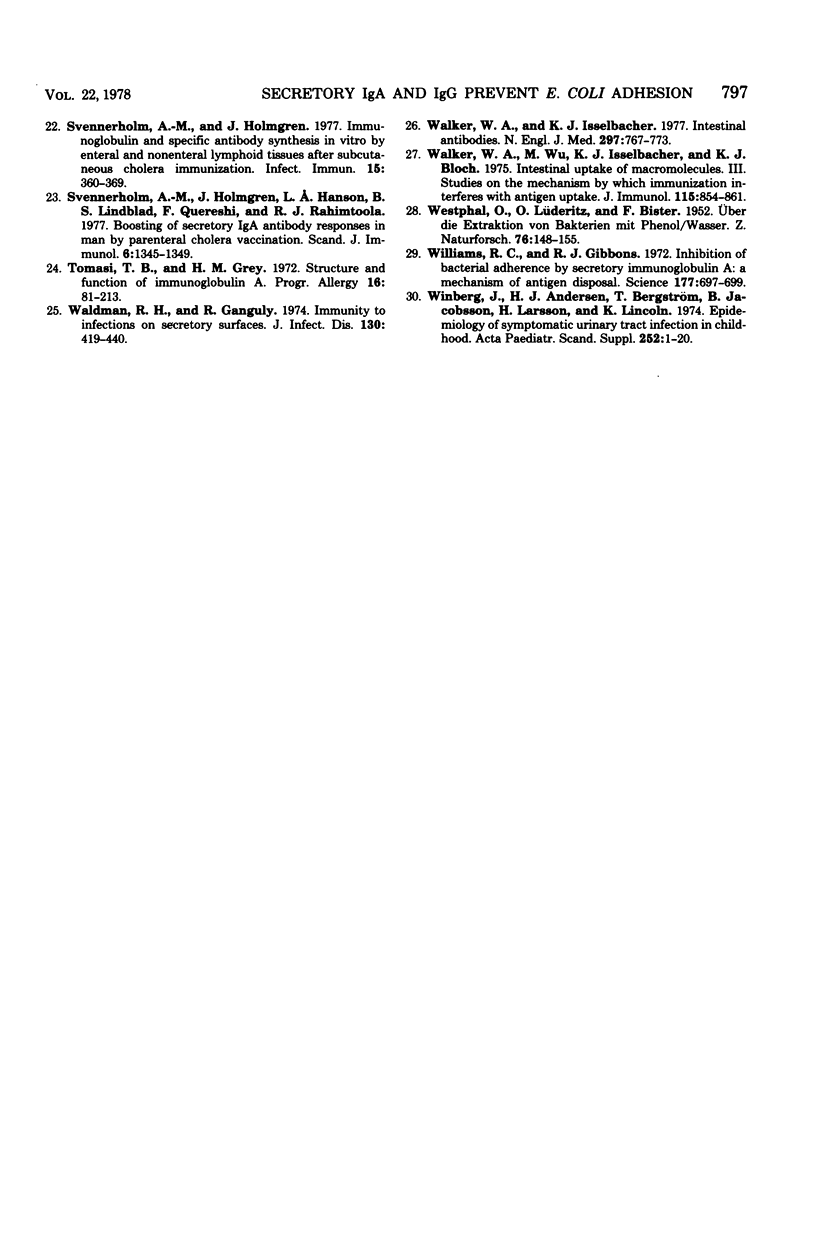
Selected References
These references are in PubMed. This may not be the complete list of references from this article.
- Akerlund A. S., Hanson L. A., Ahlstedt S., Carlsson B. A sensitive method for specific quantitation of secretory IgA. Scand J Immunol. 1977;6(12):1275–1282. doi: 10.1111/j.1365-3083.1977.tb00366.x. [DOI] [PubMed] [Google Scholar]
- Bergström T., Lincoln K., Redin B., Winberg J. Studies of urinary tract infections in infancy and childhood. X. Short or long-term treatment in girls with first or second-time urinary tract infections uncomplicated by obstructive urological abnormalities. Acta Paediatr Scand. 1968 May;57(3):186–194. doi: 10.1111/j.1651-2227.1968.tb04677.x. [DOI] [PubMed] [Google Scholar]
- Borthistle B. K., Kubo R. T., Brown W. R., Grey H. M. Studies on receptors for IgG on epithelial cells of the rat intestine. J Immunol. 1977 Aug;119(2):471–476. [PubMed] [Google Scholar]
- Eden C. S., Eriksson B., Hanson L. A. Adhesion of Escherichia coli to human uroepithelial cells in vitro. Infect Immun. 1977 Dec;18(3):767–774. doi: 10.1128/iai.18.3.767-774.1977. [DOI] [PMC free article] [PubMed] [Google Scholar]
- Edén C. S., Eriksson B., Hanson L. A., Jodal U., Kaijser B., Janson G. L., Lindberg U., Olling S. Adhesion to normal human uroepithelial cells of Escherichia coli from children with various forms of urinary tract infection. J Pediatr. 1978 Sep;93(3):398–403. doi: 10.1016/s0022-3476(78)81145-7. [DOI] [PubMed] [Google Scholar]
- Edén C. S., Hanson L. A., Jodal U., Lindberg U., Akerlund A. S. Variable adherence to normal human urinary-tract epithelial cells of Escherichia coli strains associated with various forms of urinary-tract infection. Lancet. 1976 Sep 4;1(7984):490–492. [PubMed] [Google Scholar]
- Edén C. S., Hansson H. A. Escherichia coli pili as possible mediators of attachment to human urinary tract epithelial cells. Infect Immun. 1978 Jul;21(1):229–237. doi: 10.1128/iai.21.1.229-237.1978. [DOI] [PMC free article] [PubMed] [Google Scholar]
- Emin M., Dubiski S., Cinader B. Effect of cyclic nucleotides, isoproterenol and cholera toxin on DNA synthesis triggered by mitogens. Scand J Immunol. 1978;8(2):119–125. doi: 10.1111/j.1365-3083.1978.tb00503.x. [DOI] [PubMed] [Google Scholar]
- Engvall E., Perlmann P. Enzyme-linked immunosorbent assay, Elisa. 3. Quantitation of specific antibodies by enzyme-labeled anti-immunoglobulin in antigen-coated tubes. J Immunol. 1972 Jul;109(1):129–135. [PubMed] [Google Scholar]
- Fubara E. S., Freter R. Protection against enteric bacterial infection by secretory IgA antibodies. J Immunol. 1973 Aug;111(2):395–403. [PubMed] [Google Scholar]
- Holmgren J., Svennerholm A. M. Enzyme-linked immunosorbent assays for cholera serology. Infect Immun. 1973 May;7(5):759–763. doi: 10.1128/iai.7.5.759-763.1973. [DOI] [PMC free article] [PubMed] [Google Scholar]
- Jalling B., Malmborg A. S., Lindman A., Boréus L. O. Evaluation of a micromethod for determination of antibiotic concentrations in plasma. Eur J Clin Pharmacol. 1972 Jun;4(3):150–157. doi: 10.1007/BF00561138. [DOI] [PubMed] [Google Scholar]
- Jodal U., Ahlstedt S., Carlsson B., Hanson L. A., Lindberg U., Sohl A. Local antibodies in childhood urinary tract infection: a preliminary study. Int Arch Allergy Appl Immunol. 1974;47(4):537–546. doi: 10.1159/000231248. [DOI] [PubMed] [Google Scholar]
- Kaijser B., Ahlstedt S. Protective capacity of antibodies against Escherichia coli and K antigens. Infect Immun. 1977 Aug;17(2):286–289. doi: 10.1128/iai.17.2.286-289.1977. [DOI] [PMC free article] [PubMed] [Google Scholar]
- Kaijser B., Jodal U., Hanson L. A. Studies on antibody response and tolerance to E, coli K antigens in immunized rabbits and in children with urinary tract infection. Int Arch Allergy Appl Immunol. 1973;44(2):260–273. doi: 10.1159/000230935. [DOI] [PubMed] [Google Scholar]
- Kaijser B., Larsson P., Olling S. Protection against ascending Escherichia coli pyelonephritis in rats and significance of local immunity. Infect Immun. 1978 Apr;20(1):78–81. doi: 10.1128/iai.20.1.78-81.1978. [DOI] [PMC free article] [PubMed] [Google Scholar]
- Lincoln K., Lidin-Janson G., Winberg J. Resistant urinary infections resulting from changes in resistance pattern of faecal flora induced by sulphonamide and hospital environment. Br Med J. 1970 Aug 8;3(5718):305–309. doi: 10.1136/bmj.3.5718.305. [DOI] [PMC free article] [PubMed] [Google Scholar]
- Lindberg U., Hanson L. A., Jodal U., Lidin-Janson G., Lincoln K., Olling S. Asymptomatic bacteriuria in schoolgirls. II. Differences in escherichia coli causing asymptomatic bacteriuria. Acta Paediatr Scand. 1975 May;64(3):432–436. doi: 10.1111/j.1651-2227.1975.tb03860.x. [DOI] [PubMed] [Google Scholar]
- Salit I. E., Gotschlich E. C. Type I Escherichia coli pili: characterization of binding to monkey kidney cells. J Exp Med. 1977 Nov 1;146(5):1182–1194. doi: 10.1084/jem.146.5.1182. [DOI] [PMC free article] [PubMed] [Google Scholar]
- Smith H. Microbial surfaces in relation to pathogenicity. Bacteriol Rev. 1977 Jun;41(2):475–500. doi: 10.1128/br.41.2.475-500.1977. [DOI] [PMC free article] [PubMed] [Google Scholar]
- Svennerholm A. M., Holmgren J., Hanson L. A., Lindblad B. S., Quereshi F., Rahimtoola R. J. Boosting of secretory IgA antibody responses in man by parenteral cholera vaccination. Scand J Immunol. 1977;6(12):1345–1349. doi: 10.1111/j.1365-3083.1977.tb00376.x. [DOI] [PubMed] [Google Scholar]
- Svennerholm A. M., Holmgren J. Immunoglobulin and specific-antibody synthesis in vitro by enteral and nonenteral lymphoid tissues after subcutaneous cholera immunization. Infect Immun. 1977 Feb;15(2):360–369. doi: 10.1128/iai.15.2.360-369.1977. [DOI] [PMC free article] [PubMed] [Google Scholar]
- Tomasi T. B., Grey H. M. Structure and function of immunoglobulin A. Prog Allergy. 1972;16:81–213. [PubMed] [Google Scholar]
- Waldman R. H., Ganguly R. Immunity to infections on secretory surfaces. J Infect Dis. 1974 Oct;130(4):419–440. doi: 10.1093/infdis/130.4.419. [DOI] [PubMed] [Google Scholar]
- Walker W. A., Isselbacher K. J. Intestinal antibodies. N Engl J Med. 1977 Oct 6;297(14):767–773. doi: 10.1056/NEJM197710062971407. [DOI] [PubMed] [Google Scholar]
- Walker W. A., Wu M., Isselbacher K. J., Bloch K. J. Intestinal uptake of macromolecules. III. Studies on the mechanism by which immunization interferes with antigen uptake. J Immunol. 1975 Sep;115(3):854–861. [PubMed] [Google Scholar]
- Williams R. C., Gibbons R. J. Inhibition of bacterial adherence by secretory immunoglobulin A: a mechanism of antigen disposal. Science. 1972 Aug 25;177(4050):697–699. doi: 10.1126/science.177.4050.697. [DOI] [PubMed] [Google Scholar]
- Winberg J., Andersen H. J., Bergström T., Jacobsson B., Larson H., Lincoln K. Epidemiology of symptomatic urinary tract infection in childhood. Acta Paediatr Scand Suppl. 1974;(252):1–20. doi: 10.1111/j.1651-2227.1974.tb05718.x. [DOI] [PubMed] [Google Scholar]


